The market is pricing a much-quicker transition to a taper and hike this time
 Read full post at forexlive.com
Read full post at forexlive.com
A comparison of the financial crisis and now

How quick will the Fed move? That’s the question underlying all the anxiety in the bond market that’s spread everywhere else. ADFter a brief bounce, US equities are lower again today and after falling to 0.73%, US 5-year yields are at 0.80%.
Here was the Fed timeline after the financial crisis:
- Taper tantrum (May 2013)
- Formal taper announcement (June 2013)
- Taper begins (Dec 2013)
- QE halted (Oct 2014)
- First hike (Dec 2015)
- Balance sheet normalization announced (June 2017)
- Normalization begins (Oct
2017)
BMO highlights that the market is increasingly pricing in a much quicker taper and transition to rate hikes this time:
At issue is that the time between the taper
tantrum and the official end of QE end was 17 months and then another 14 months
before liftoff. The market is currently pricing in effectively a 6 month-taper
to end and 6 months until first hike – or some combination that results in the
transition which took 31 months last cycle to be truncated with a year.
Certainly, it could happen – but that would imply something has changed
dramatically in the Fed’s interpretation of the balance of risks surrounding
the inflation outlook.
The counter-argument might be that a pandemic-induced recession is different from a financial crisis and that the US fiscal response has been dramatically more-powerful, with perhaps nearly $5 trillion more to come.
